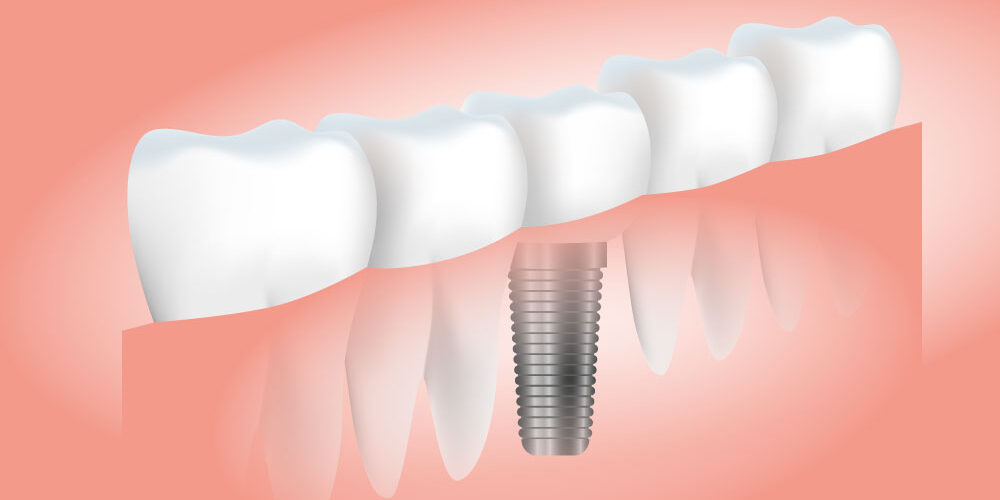
Dental implants are used as the foundation upon which tooth replacements are placed. They can be used to support a crown for a single tooth or multiple teeth, or to support a bridge for multiple teeth. Alternatively, they can be designed to retain a complete or partial denture when multiple teeth are lost.
The Tooth Implant Process
After dental implants are placed, there is generally a waiting period that allows the implant to form a strong bond between it and the surrounding bone. Sometimes, additional bone is placed around an implant to increase support of the implant or provide clearance from specific anatomical structures, such as the sinus floor for example. If this occurs, then this waiting time can be extended. During this period of time, an appliance can be made that places an artificial tooth or teeth over the implant area, so it gives the illusion of not having any missing teeth. Once the implant integrates into the bone, it is ready to be used.
In a situation where only a single tooth is lost, the ideal way of replacing it is through the use of a single dental implant and tooth crown. This is because the crown will be permanently fixed into place, look and function very similar to the tooth it replaced, and it can be brushed and flossed just like a natural tooth. The procedure of placing a crown on the implant is a two visit procedure, similar to that of making a crown for a natural tooth. An impression of the implant is taken on the first visit, and then it is sent to the laboratory to be meticulously prepared. On the second visit, the new crown is fitted and cemented permanently into place.
Crowns and bridges placed on implants use the same materials as those used on natural teeth. A post is used, called an abutment, which servers to link the crown and bridge to the implant. Sometimes, depending on the case, this abutment needs a very specific design and/or material based on the bone and gum level in which it is placed, and in these cases a custom abutment is used, as opposed to a standard abutment.
In order to determine where to place the tooth implant so it can be used properly, several tools are used. Sometimes special x-rays are taken, called extraoral x-rays, to better assess the area in which the implant is to be place. Some common examples include a panoramic x-ray, 3D x-rays (specifically, CT scans), tomograms, and cephalometric projections. Generally, a diagnostic wax-up and surgical stent are made. The wax-up gives valuable information in terms of where the implant must be positioned, and the stent guides the surgical placement of the implant.
Implant Dentistry Options for Multiple Missing Teeth
In a situation where multiple teeth are missing, there are a couple of available options:
Bridges
One possibility, and generally the most practical option, includes using a bridge to restore the space. In this situation, generally two implants are placed on the ends of the bridge for support. The process to fabricate the bridge for the implants is much like that of fabricating one for natural teeth. Daily home care for the bridge is the same as one made for natural teeth. Another option is to replace each missing tooth with an implant and crown. This is more ideal, but is also a more costly option.
Dentures
Replacing the missing teeth with dentures is yet another option. In cases where there is poor support for the denture, such as little available anatomy, or there is poor retention, such as unfavorable anatomy, poor bite or biting control, then implants can be a great option for providing this support and/or retention that is needed. There are several ways to go about doing this with implants, which will depend on the case to determine which method is best. A common way to integrate the implant to the denture is through the use of locators. The locator gets fastened to the implant on one end and the other end sticks out above the gum line, with the top of it generally in the form of a ball. The receiving end of this locator, which is fitted with a rubber “grommet” around the inside of it to give it a more predictable and tighter fit, gets imbedded into the surface of the denture. So, when the denture is positioned in and out of the mouth, it snaps on and off of the locators, respectively. The denture will be afforded a better fit and function through the use of these locators as they act to hold it in place when talking and chewing. To maintain the implants, locators, and denture, the denture and locators must be cleaned daily. The locator will also wear with time and require servicing and/or replacement.
Don't forget to fill out the forms!
Make sure you download our forms ahead of time so you can walk in to your appointment with no waiting time.
